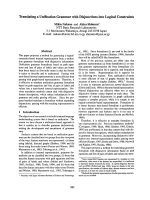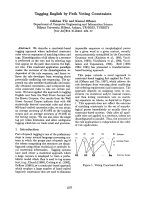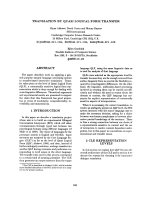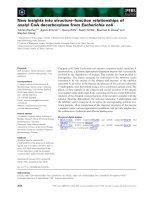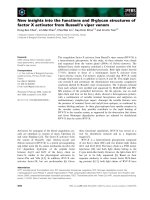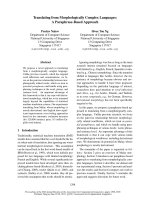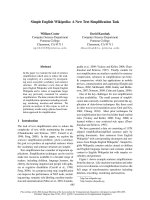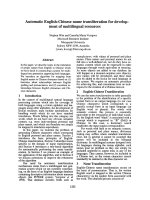Báo cáo khoa học: "TRANSLATING ENGLISH INTO LOGICAL FORM" docx
Bạn đang xem bản rút gọn của tài liệu. Xem và tải ngay bản đầy đủ của tài liệu tại đây (589.16 KB, 8 trang )
TRANSLATING ENGLISH INTO LOGICAL FORM'
Stanley J. Rosenscbein
Stuart M, Shieber
ABSTRACT
A
scheme for syntax-directed translation that mirrors com-
positional model-theoretic semantics is discussed. The scheme is the
basis for an English translation system called PArR and was used to
specify a semantically interesting fragment of English, including such
constructs as tense, aspect, modals, and various iexically controlled verb
complement structures. PATR was embedded in a question-answering
system that replied appropriately to questions requiring the computa-
tion of logical entailments.
I INTRODUCTION
When contemporary linguists and philosophers speak
of "semantics," they usually mean m0del-theoretic semantics
mathematical devices for associating truth conditions with Sentences.
Computational linguists, on the other hand, often use the term
"semantics" to denote a phase of processing in which a data structure
(e.g., a formula or network) is constructed to represent the meaning
of a sentence and serve as input to later phases of processing. {A bet-
ter name for this process might be "translation" or "traneduction.")
Whether one takes "semantics" to be about model theory or translation,
the fact remains that natural languages are marked by a wealth
of
com-
plex constructions such as tense, aspect, moods, plurals, modality, ad-
verbials, degree terms, and sententiai complemonts that make seman-
tic specification a complex and challenging endeavor.
Computer scientists faced with the problem of managing
software complexity have developed strict design disciplines in their
programming methodologies. One might speculate that a similar re-
quirement for manageability has led linguists (since Montague, at least)
to follow a discipline of strict compositiouality in semantic specification,
even though model*theoretic semantics per me does not demand it.
Compositionaiity requires that the meaning of a pbrase be a function
of the meanings of its immediate constituents, a property that allows
the grammar writer to correlate syntax and semantics on a rule-by-rule
basis and keep the specification modular. Clearly, the natural analogue
to compositionality in the case of translation is syntax-directed trans-
lation;
it is this analogy that we seek to exploit.
We describe a syntax-directed translation scheme that bears
a close resemblance to model-theoretic approaches and achieves a level
of perspicuity suitable for the development of large and complex gram-
mars by using a declarative format for specifying grammar rules. In our
formalism, translation types are associated with the phrasal categories
of English in much the way that logical-denotation types are associated
Artificial Intelligence Center
SRI International
333 Raveoswood Avenue
Menlo
Park, CA 94025
with phrasal categories in model-theoretic semantics. The translation
'types are classes of data
objects
rather than abstract
denotations,
yet
they play much the same role in the translation process that denotation
types play in formal semantics.
In addition to this parallel between logical types and trans-
lation types, we have intentionally designed the language in which
translation rules are stated to emphasize parallels between the syntax-
directed translation and corresponding model-theoretic interpretation
rules found in, say, the GPSG literature [Gazdar, forthcoming]. In
the GPSG approach, each syntax rule has an associated semantic rule
(typically involving functional application) that specifies how to com-
pose the meaning of a phrase from the meanings of its constituents.
In an analogous fashion, we provide for the translation of a phrase
to be synthesized from the translations of its immediate constituents
according to a local rule, typically involving symbol/c
application and
~-conversiou.
It should be noted in passing that doing translation rather
than model theoretic interpretation offers the temptation to abuse the
formalism by having the "meaning" (translation) of a phrase depend
on syntactic properties of the translations of its constituents for in-
stance, on the order of conjuncts in a logical expression. There are
several points to be made in this regard. First, without severe a priori
restrictions on what kinds of objects can be translations (coupled with
the associated strong theoretical claims that such restrictions would
embody) it seems impossible to prevent such abuses. Second, as in the
case of programming languages, it is reasonable to mmume that there
would emerge a set of stylistic practices that would govern the actual
form of grammars for reasons of manageability and esthetics. Third, it
is still an open question whether the model*theoretic program of strong
compositiouality will actually succeed. Indeed, whether it succeeds or
not is of little concern to the computational linguist, whose systems, in
any event, have no direct way of using the sort of abstract model being
proposed and whose systems must, iu general, be based on deduction
(and hence translation).
The rest of the paper discusses our work in more detail.
Section II presents the grammar formalism and describes PATR, an
implemented parsing and translation system that can accept a gram-
mar in our formalism and uses it to process sentences. Examples of
the system's operation, including its application in a simple deductive
question-answering system, are found in Section HI. Finally, Section
IV describes further extensions of the formalism and the parsing sys-
tem. Three appendices
are
included: the first contains sample
gram-
mar rules; the second contains meaning postulates (axioms) used by
the question-answering system; the third presents a sample dialogue
session.
"This research wns supported by the Defense Advanced Research Projects Agency
under Contract N000SO-SO-C 0575 with the Naval Electronic Systems Conunand.
The views and conclusions contained in this document are those of the authors and
should not be interpreted ns representative of the ol~cial policies, either expres~.d
or implied, of the Defense Ad~eanced Research Projects Agency or the United States
Government.
il A GRAMMAR FORMALISM
A General Characterization
Our grammar formalism is beet characterized as n specialized
type of augmented context-free grammar° That is, we take a grammar
to be a set of context-fres rules that define a language and associate
structural descriptions (parse trees) for each sentence in that language
in the usual way. Nodes in the parse tree are assumed to have a set of
features which may assume binary values (True or False), and there is
a distinguished attribute the "translation' whoee values range over
a potentially infinite set of objects, i.e., the translations of English
phrases.
Viewed more abstractly, we regard translation as a binary
relation between word sequences and logical formulas. The use of
a relation is intended to incorporate the fact that many word se-
quences have several logical forms, while some have none at all.
Furthermore, we view this relation as being composed (in the mathe-
matical sense) of four simpler relations corresponding to the conceptual
phases of analysis: (1) LEX (lexical analysis), (2) PARSE (parsing), (3)
ANNOTATE (assignment of attribute values, syntactic filtering), and
(4) TRANSLATE (translation proper, i.e., synthesis of logical form).
The domains and ranges of these relations are as follows:
Word Sequences -LEX-*
Morpheme Sequences -PARSE-*
Phrase Structure Trees -ANNOTATE-*
Annotated Trees -TRANSLATE-*
Logical Form
The relational composition of these four relations is the full translation
relation associating word sequences with logical forms. The subphases
too are viewed as relations to reflect the inherent nondeterminism of
each stage of the process. For example, the sentence =a hat by every
designer sent from Paris was felt" is easily seen to be nondeterminis-
tic in LEX ('felt'), PARSE (poetnominal modifier attachment), and
TRANSLATE (quantifier scoping).
It should be emphasized that the correspondence between
processing phases and these conceptual phases is loose. The goal of
the separation is to make specification of the process perspicous and to
allow simple, clean implementations. An actual system could achieve
the net effect of the various stages in many ways, and numerous op-
timizatious could be envisioned that would have the effect of folding
back later phases to increase efficiency.
B
The Relations LEX, PARSE, and ANNOTATE
We now describe a characteristic form of specification ap-
RULES:
constant corn,' - (~
e
(X Q CX
x
CP
CQ x)))))
S * NPVP
Truss: VP' [NP']
VP -* T~qSEV
Aano: [-~Transitivo(V) ]
Tr,=,: {
couP' [~']
t~'] }
lEXICON:
If -* John
Aano: [Proper(W) ]
Truss: { John
}
TENSE
-* &put
Trash:
{ (X x
CpastX))
}
V-*go
Anon: [ -~Trasnitivn(V) ]
Trnn:
{ C~ x Can x)) }
Figure 1: Sample specification of augmented phrase structure
grammar
propriate to each phase and illustrate how the word sequence "John
went" is analyzed by stages as standing in tbe translation relation
to "(past (go john))" according to the (trivial) grammar presented in
Figure 1.
Lexieal analysis is specified by giving a kernel relation between
individual words and morpheme sequences I (or equivalently, a mapping
from words to sets of morpheme sequences), for example:
John -* (john) :
vent -* (kput go) :
persuaded -+ (kput persuade) o
(kppl persuadn) :
The kernel relation is extended in a standard fashion to the
full LEX relation. For example, "went" is mapped onto the single
morpheme sequence (&past go), and "John" is mapped to (john). Thus,
by extension, "John went" is transformed to (John &post go) by the
lexical analysis phase.
Parsing is specified in the usual manner by a context-free
grammar. Utilizing the eontext,-free rules presented in the sample
system specification shown in Figure 1, (John 8cpast go) is transformed
into the parse tree
(S (NP john)
C~
(r~rsE tput)
Cvso)))
Every node in the parse tree has a set of associated features.
The purpo6e of ANNOTATE is to relate the bate parse tree to one
that has been enhanced with attribute values, filtering out three that
do not satisfy stated syntactic restrictions. These restrictions are given
as Boolean expressions associated with the context-free rules; a tree is
properly annotated only if all the Boolean expressions corresponding
to the rules used in the analysis are simultaneously true. Again, using
the rules of Figure 1,
lof course, more sophisticated spprotehe~ to morpholoslesl sualysls would seek
to analyze the LEX relgtion more fully. See, for example, ~Kartunnen, lgS2J gad
[Ksplan, 19811.
(s (SP john)
(W (~ aput)
(V go)) )
is transformed into
(S (NP:
Proper
john)
(W : "~ Trandlive
(~ ~aet)
(V:
-Transitive
go)))
C The Relation TRANSLATE
Logical-form synthesis rules are specified as augments to the
context-free grammar. There is a language whose expressions denote
translations (syntactic formulas); an expression from this language is
attached to each context-free rule and serves to define the composite
translation at a node in terms of the translations of its immediate
constituents. In the sample sentence, TENSE' and V' {the translations
of TENSE and V respectively) would denote the ),-expressions specified
in their respective translation rules. VP' {the translation of the VP)
is defined to be the value of (SAP (SAP COMP' TENSE') V'), where
COMF' is a constant k-expression and SAP is the
symbolic-application
operator. This works out to be (k X [past (go X))). Finally, the symbolic
application of VP' to N'P' yields (past (go John)). (For convenience we
shall henceforth use square brackets for SAP and designate (SAP a ~)
by a[~].)
Before describing the symbolic-application operator in more
detail, it is necessary to explain the exact nature of the data objects
serving as translations. At one level, it is convenient to think of
the translations as X-expressions, since X-expressions are a convenient
notation for specifying how fragments of a translation are substituted
into their appropriate operator-operand positions in the formula being
assembled-especially when the composition rules follow the syntactic
structure as encoded in the parse tree. There are several phenomena,
however, that require the storage of more information at a node than
can be represented in a bare k-expression. Two of the most conspicuous
phenonema of this type are quantifier scoping and unbounded depen-
dencies ("gaps").
Our approach to quantifier scoping has been to take a version
of Cooper's storage technique, originally proposed in the context of
model-tbeoretic semantics, [Cooper, forthcoming[ and adapt it to the
needs of translation. For the time being, let us take translations to
be ordered pairs whose first component (the
head) is an
expression
in the target language, characteristically a k-expression. The second
component of the pair is an object called storage, a structured collection
of sentential operators that can be applied to a sentence matrix in such a
way as to introduce a quantifier and "capture" a free variable occurring
in that sentence matrix. 2
For example, the translation of "a happy man" might be <
m , (X S (some m (and (man m)(happy m)) S)) >.s Here the head is m
(simply a free variable), and storage consists of the X-expression (k S
2in the sample grammar presented in Appendix A, the storage.formlng operation
is notated
mk.mbd.
3Followlng [Moore, lO80~, a quantified expression is of the form (quauti6er, variable,
restriction, body)
). If the verb phrase "sleeps ~ were to receive the translation < (X X
(sleep X)), ~ > (i.e., a unary predicate as head and no storage), then
the symbolic application of the verb phrase translation to the noun
phrase translation would compose the heads in the usual way and take
the "uniou" of the storage yielding < (sleep m), (k S (some m (and
(man m)(happy m)) S)) >.
We define an operation called ~pull.s," which has the effect
of "pulling" the sentence operator out of storage and applying it to
the head. There is another pull operation, pull.v, which operates on
heads representing unary predicates rather than sentence matrices.
When pull.s is applied in our example, it yields < (some m (and (man
m)(happy m)) (sleep m)), ~b >, corresponding to the translation of the
clause ~a happy man sleeps." Note that in the process the free vari-
able m has been "captured." In model-theoretic semantics this cap-
ture would ordinarily be meaningless, although one can complicate the
mathematical machinery to achieve the same effect. Since
translation
is fundamentally a
syntactic
process, however, this operation is well-
defined and quite natural.
To handle gaps, we enriched the translations with a third com-
ponent: a variable corresponding to the gapped position. For example,
the translation of the relative clause ".,.[that] the man saw" would be
a
triple: < (past (see X Y)), Y, (k S (the X (man X) $))>, where
the second component, Y, tracks the free variable corresponding to the
gap. At the node at which the gap was to be discharged, X-abstraction
would occur (as specified in the grammar by the operation "uugap')
producing the unary predicate (X Y (past (see X Y))), which would
ultimately be applied to the variable corresponding to the head of the
noun phrase.
It turns out that triples consisting of (head, var, storage)
are adequate to serve as translations of a large class of phrases, but
that the application operator needs to distinguish two subcases (which
we call type A and type B objects). Until now we have been discussing
type A objects, whose application rule is given (roughly) as
< hal,vat,san>l< hal',vat',san'>[
-~ <(hd hd'),var LI var', sto i3 sto'>
where one of vat or vat' must be null. In the ease of type B objects,
which are assigned primarily as translations of determiners, the rule is
< h d,var ,san > [< hd',var',sto' >]
= <var, var', hd(hd') U sto U sto'>
For example, if the meaning of "every" is
every' ~- <(k P (X S (every X (P X) S))), X, ~b>
and the meaning of ~man" is
man' < man, ~, ~ >
then the meaning of "every man" is
every'[man'] = ( X , ¢, (X S (man X) S)> ,
as expected.
Nondeterminism enters in two ways. First, since pull opera,
tions can be invoked nondeterministically at various nodes in the parse
tree (as specified by the grammar), there exists the possibility of com-
puting multiple scopings for a single context-free parse tree. (See
Section III.B for an example of this phenomenon.) In addition, the
grammar writer can specify explicit nondeterminism by associating
several distinct translation rules with a single context-free production.
In this case, he can control the application of a translation schema by
specifying for each schema a guard, a Boolean combination of features
that the nodes analyzed by the production must satisfy in order for the
translation schema to be applicable.
D Implementation of a Translation System
The techniques presented in Sections H.B and II.C were imple-
mented in a parsing and translation system called PATR which was
used as a component in a dialogue system discussed in Section III.B.
The input to the system is a sentence, which is preprocessed by a
lexical analyzer. Parsing is performed by a simple recursive descent
parser, augmented to add annotations to the nodes of the parse tree.
Translation is then done in a separate pass over the annotated parse
tree. Thus the four conceptual phases are implemented as three actual
processing phases. This folding of two phases into one was done purely
for reasons of efficiency and has no effect on the actual results obtained
by the system. Functions to perform the storage manipulation, gap
handling, and the other features of translation presented earlier have
all been realized in the translation component of the running system.
The next section describes an actual grammar that has been used in
conjunction with this translation system.
III EXPERIMENTS IN PRODUCING AND USING
LOGICAL FORM
A A Working Grammar
To illustrate the ease with which diverse semantic features
could be handled, a grammar was written that defines a semantically
interesting fragment of English along with its translation into logical
form [Moore, 1981]. The grammar for the fragment illustrated in this
dialogue is compact occupying only a few pages, yet it gives both syntax
and semantics for modais, tense, aspect, passives, and lexically control-
led infinitival complements. (A portion of the grammar is included
as Appendix A.) 4 The full test grammar, Io,~ely based on DIAGRAM
[Robinson, 1982] but restricted and modified to reflect changes in a~
proach, was the grammar used to specify the translations of the sen-
tences in the sample dialogue of Appendix C.
B An Example of the System's Operation
The grammar presented in Appendix A encodes a relation
between sentences and expressions in logical form. We now present a
sample of this relation, as well as its derivation, with a sample sentence:
"Every man persuaded a woman to go."
Lexical analysis relates the sample sentence to two morpheme
streams:
every man &ppi persuade a woman to go
4Since this is just a small portion of the actual grammar selected for expository
purposes, many of the phrasal categories and annotations will seem unmotivated
and needlessly complex. These categories and annotations m'e utilized elsewhere
in the test grammar.
*, every man ,~past persuade a woman to go.
The first is immediately eliminated because there is no context-free
parse for it in the grammar. The second, however, is parsed as
[S
(SDEC (NP
(DETP (DDET (VET every)))
C~u
CN0m~V (SOUN
Cs
re,a)))))
(Pn~ICar~ (*u~ (TE~E kpaat))
(VPP (V? CV?T
(Vpersuado)))
(~
(DET? CA
a))
(~u (Nnm~ (~vtm
CN
womm)))))
(INFINITIVE (TO to)
CV~ Cv? CWT CV go]
While parsing is being done, annotations are added to each
node of the parse tree. For instance, the NP -* DETP NOM rule
includes the annotation rule AGREE( NP, DETP, Definite ). AGREE
is one of a set of macros defined for the convenience of the grammar
writer. This particular macro invocation is equivalent to the Boolean
expression Definite(NP) ~ Definite(DETP). Since the DETP node itself
has the annotation Definite as a result of the preceding annotation
process, the NP node now gets the annotation Definite as wello At
the bottom level, the Definite annotation was derived from the lexical
entry for the word "evesy'. s The whole parse tree receives the following
annotation:
[S Cb'~O (lqP:
Delinite
(DETP: DeBnite
CDDET:
DeBnite
(DET: DeBuite
eve1"y)
) )
CNOU (stump CNO~ CSm~)))))
CPR~ICATE CAU~ CTENSE ~put))
(VPP CVP:
Active
(VPT:
Active, Ttansitlve, Takesln?
(V:
Active, Transitive, Takesfn[
porsuade) ) )
0~'
(DET? CA
a) )
CNOU C~la'~ C~ml
C~ ,,on~)))))
CDr~ISZTZ'W (TO
to)
(vPP (w:
Active
(VPT:
Active
Cv:
Active
sol
Finally, the entire annotated parse tree is traversed to assign
translations to the nodes through a direct implementation of the process
described in Section II.C. (Type A and B objects in the following
examples are marked with a prefix 'A:' or 'B:'.) For instance, the
VP node covering (persuade a woman to go), has the translation rule
VPT'[N'P'][INFINITIVE']. When this is applied to the translations of
the node's constituents, we have
CA:
CA X
CA
P
(~
T (persuade ¥ X
(P
X)))~
[,CA: X2. ~,. C~
S
(some X2 Cwomu X2)
S))~]
[cA:
(~x C~x))~]
which, after the appropriate applications are performed, yields
CA:
CAP (~Y (persuade YX2 CPX2)))).
~,
(A
S (some
X2 (~- X2)
S))~
5Note that, although the annotation phase was described and is implemented pro-
cedurally, the process actually used guarantees that the resulting annotation is
ex" "t|y the one specified declaratlve~y by the annotation rules.
[o,: (A x (gox))>]
=
CA:
()/¥
(persuadeTX2
(goX2))).
~b,
CA S (some X2
(roman
X2) S))~
After the past operator has been applied, we have
<A: CA T (pant (persumde YX2 (goX2)))). ~b,
CA S
(some X2
(~znu X2) S)))
At this point, the pull operator (pull.v) can be used to bring the
quantifier out of storage, yielding 6
<A: CA Y (some ~2 (womb ][2) (pant (peramado
T~
(go Yg))))).
This will ultimately result in "a woman" getting narrow scope. The
other alternative is for the quantifier to remain in storage, to be pulled
only at the full sentence level, resulting in the other scoping. In Figure
2, we have added the translations to all the nodes of the parse tree.
Nodes with the same translations as their parents were left unmarked.
From examination of the S node translations, the original sentence is
given the fully-scoped translations
(every X2
(man
](2)
(some Xi
(woman
Xi) (paSt (persuade %,9 X!
(go Xl)))))
and
(some XI (vo~ Xl)
(every X~2 (nan
X2) (pant
(persuade X2
Xl
(go
Xl)
))) )
C A
Simple Question-Answering System
As mentioned in Section I, we were able to demonstrate the
semantic capabilities of our language system by assembling a small
question-answering system. Our strategy was to first translate English
into logical formulas of the type discussed in [Moore, 1981], which
were then postprocessed into a form suitable for a first-order deduc-
tion system. 7 (Another possible approach would have been to translate
directly into first-order logic, or to develop direct proof procedures for
the non-first-order language.) Thus, we were able to integrate all the
components into a question-answering system by providing a simple
control structure that accepted an input, translated it into logical form,
reduced the translation to first-order logic, and then either asserted the
translation in the case of declarative sentences or attempted to prove it
in the case of interrogatives. (Only yes/no questions have been imple-
mented.)
The main point of interest is that our question-answering
system was able to handle complex semantic entailments involving
tense, modality, and so on that, moreover, it was not restricted to
extensional evMuation in a data base, as with conventional question-
answering systems. For example, our system was able to handle the
entailments of sentences like
John could not have been persuaded to go.
(The transcript of a sample dialogue is included as Appendix C.)
6For convenience, when a final constituent
o1'
a translation is ~ it is often not
written. Thus we could have written <A: (k Y (some ) )> in this cue.
7We used a connection graph theorem prover written by Mark Stickel [Stlckel,
forthcoming].
(S: <A: (pant (persuade XI X2 (go ~))). ~.
(A S (every X1 (nan X1) S))
()~ S
(some ~
(veto ][2) S))>,
<A: (some ][2 (~man X2) (past Cpersua4e X1 Y,2 (go Yo)))) 0 ~.
(~ 8 (every Zl (man ][I) S))>
<A: (everyX2 CnanX2)
(some
XI
(woman X1) (pant (persuade X2 Xl (go Y~)) )))>
cA:
(sou Xl (wuan
X1)
(every ][2 (man X2) (pant (p0rsuade X2 li (go ][2)) ) )) >
(SV~
(NP:
<A:
Xl.
~. (A S
(everyXl
(muXl)S)))
CDKTP:
¢~:
CA
P
(~ S
(every X
(PI) S))).
X~
(DDET (DET every)))
(NDU: cA: CA X (man X)))
(None (Nmm (x m~n)))))
(PREDICATE: <A: (AX (past (persuade YX2 (goX2)))). ~b.
CA S (some X2 (woma X2) S))),
<X:
CA X (son X2 (woeanX2)
(pant (persuade YX2 (goX2))))).
(AU~P:
o,: CA
P
CA
X
(pant
(P x))))>
C'X'~
a~,,.t))
(VPP:
<A: (A ¥ (persuade ¥ ][2 (go ][2))). ~b.
CA S (some X2
(wn X2)
S))~
(VP
(VPT:
cA:
(XX
CA P
()~ Y (persuade ¥X (P ¥))))
(V persuade)))
(~: cA: X2. ~, CA S (someX2 (wona Z2) S))~
(DETP:
<S: (kP
(AS
(SoNX (PX)
S))).
X~
CA n))
(~li: (A: (XX (wommX))>
(N0~ (N0uw (w ,mm~)))))
(INFINITIVE (TO:
none
to)
(VPP:
ca: (>,X (goX))>
(w (vPT (v so]
Figure 2:.
Node-by-node translation of a sample sentence
The reduction of logical form to first-order logic
(FOL)
was
parameterized by a set of recursive expansions for the syntactic ele-
ments of logical form in a manner similar to Moore's use of an
sxiomatization of a modal language of belief. [Moore, 1980] For ex-
ample, (past P) is expanded, with respect to a possible world w, as
(some w2 (and (past w2 w) <P,w2>))
where "<P,w2>" denotes the recursive FOL reduction of P relative
to the world w2. The logical form that was derived for the sample
sentence "John went ~ therefore reduces to the first-order sentence
(some w (and (past w REALWORLD)(go w John))).
More complicated illustrations of the results of translation and reduc-
tion are shown in Figure 3. Note, for example, the use of restricted
quantification in LF and ordinary quantification in FOL.
To compute the correct semantic entailments, the deduction
system was preloaded with a set of meaning postulates (axioms) giving
inferential substance to the predicates associated with lexical items (see
IMrffT:
every ntanus~ be
happy
iF: (everyX (m X)
(tacosnry (tad (happy X)
(thlngX))))
FOL:
(every x0172
(implies (mtuREALWORLDxOI72)
(overywO173
(implies (posnBEALgORLD~173)
(tad (happy~O175zOt72)
(~hi~Ot73z0172))))))
II~UT: bill persuaded john to go
iF: (ptat (porsutde bill john (go john)))
FOL: (some s0175
(ud (pant
w0175 RF AL|QP.LD)
(sou wOrTS
(Imd (permaade
w0175
bill
John
wOlT§)
(go wOlTe John)))))
Figure
3:
Translation to LF and Reduction to FOL
Appendix B).
IV FURTHER EXTENSIONS
We are continuing to refine the grammar formalism and im-
prove the implementation. Some of the refinements are intended to
make the annotations and translations easier to write. Examples in-
clude:
Allowing nonbinary features, including sets of values, in the
annotations and guards (extending the language to include
equality and set operations).
Generalizing the language used to specify synthesis of logi-
cal forms and developing a more uniform treatment of
translation types.
Generalizing the "gap* variable feature to handle ar-
bitrary collections of designated variables by using an
"environment" mechanism. This is useful in achieving a
uniform treatment of free word order in verb complements
and modifiers.
In addition, we are working on extensions of the syntactic
machinery, including phrase-linking grammars to handle displacement
phenomena [Peters, 1981], and methods for generating the augmented
phrase structure grammar through a metarule formalism similar to
that of [Konolige, 1980]. We have also experimented with alternative
parsing algorithms, including a chart parser [Bear, 197g] adapted to
carry out annotation and translation in the manner described in this
paper.
REFERENCES
Bear, John, and Lanri Karttunen. PSG: A Simple Phrase Structure
Parser.
Texas Linguistic Forum,
vol. 14. 1979.
Cooper, Robin.
Quantification and Syntactic Theory.
Forthcoming.
Reidel, Dordrecht.
Gazdar, Gerald. Phrase Structure Grammar. To appear in Jacobsen,
O. and G. K. Pullum (eds.)
On the Nature of Syntactic
Representation.
Kaplan, R. M., and Martin Kay. Personal communication. 1981.
Karttunen, Lauri, Rebecca Root, and Hans Uszkoreit. Morphological
analysis of Finnish by computer. Paper presented at the ACL
session of the 1981 LSA Annual Meeting, New York, December
1981.
Konolige, Karl. Capturing linguistic generalizations with metarules in
an annotat.d phrase-structure grammar. Proceedings of the 18th
Annual Meeting of the Association for Computational Linguistics,
University of Pennsylvania, Philadelphia, June 1980.
Moore, Robert C. Problems in Logical Form. Proceedings of the 19th
Annual Meeting of the Association for Computational Linguistics,
Stanford University, Pale Alto, June, 1981.
Moore, Robert C. Reasoning About Knowledge and Action. SRI
International, Technical Note 191. October, 1980.
Peters, Stanley, and Robert W. Ritchie. Phrase Linking Grammars.
December 1981. Unpublished manuscript.
Robinson, Jane. DIAGRAM: A Grammar for Dialogues°
Communications of the ACM,
~5:1 (January, 1982) 27 47.
Stickel, Mark. A Non-Clausal Connection Graph Resolution Theorem
Proving Program. Forthcoming.
APPENDIX A. Sample Grammar Rules
The following is a portion of a test grammar for the PATR
English translation system. Only those portions of the grammar uti-
lized in analyzing the sample sentences in the text were included.
The full grammar handles the following constructs: medals, adjec-
rivals, tense, predicative and nonpredicative copulatives, adverbials,
quantified noun phrases, aspect, NP, PP, and infinitival complements,
relative clauses, yes/no questions, restricted wh-questions, noun-noun
compounds, passives, and prepositional phrases as predicates and ad*
jectivals.
a~smffiamumam GrlmlN, r
hles •.m~
~mssmtm
Cone~mt EQ' • curry
(X,,AIIBDA
(X ¥) (equal X ¥))
Coast&at PASS' 8
<A: (LA~DA P (LAIEDA X ((P X) T))). NIL,
(IIX.IIBD (QUOTE (LAIIBDA S (some T (thing Y) S)))) >
Constant PhSSIIF' •
<A: (LAM~)A P (LAMBDA I (~& x (((P x) I) ¥)))). NIL,
(MI(.MBD (QUOTE (IAMBDA S Csome ¥
(thing ¥) S))))
>
AUXP-> TENSE;
Trtaslation:
TENSE'
DDET -> DET:
Annotation:
[ Defiaite(DDET) ]
Trtaslation:
DET'
DETP
->
A;
Annotation:
[
~Definite(DETP)
]
Translation:
A'
DETP
->
DDET;
Annotation:
[ AGREE(DET?. DDET, Definite)
]
Translation:
DDET'
II~INITIV~
-~ TO VPP;
Annotation:
[
AGREECINFINITIVE. VPP,
G*ppy. |h) ]
Translation:
pull.v(VPP')
NON ->
NO~qD;
Annotation:
[ AOREE(NOM. NOMHD.
O~ppy) ]
Translation:
NON~ID'
NOMHD -) NOUN;
Translation:
NOUN'
NOUN
->
N;
Translation:
N'
NP -)
DE?P
~M;
Annotation:
[ AOP~CNP.
NOM. Gappy)
]
[ Predicative(NP)
%/
~Predicative(NP) ]
[AGREE(N~. DETP,
Definite) ]
Translation:
~Predica~ive(~):
DET~'[NOM']
Definite(NP) A Predicative(NP): E~'[DETP'[NQM']]
~Definite(NP) • Predicative(NP): NON'
PREDICATE -> AU]~ ~;
Annotation:
[ AORE~(PREDICATE. VPP. Active. 0appy. ~h) ]
Translation :
pull.v(A~' [VPP'])
S
-)
SDEC;
Annotation:
[ ~Oappy(.~'~EC) ]
[ ~(~EC) ]
Translation :
SDEC'
&DEC -) NP PREDICATE;
Annotation:
[ 0appy(NP) V Gappy(I~DICATE) ¢-) G~ppy(S)EC) ]
[ ~Predicative(NP) ]
[
|h(N~) ~/
|b(PREDICATE)
<=>
Wb(SDEC) ]
[ - (Onppy (NP) a Onppy (PKEDICATE)) ]
Truslation:
pull.s(PR~DICATE'[NP'])
VP -, VPT;
Annotation:
[ ~TrLnsitive(VPT) ]
[-TLkeelnZCV~T)
]
[ Active(VPT) ]
[ ActiveCVP) ]
Translation:
VPT'
VP
->
VPT NP I~FINITIVE;
Annotation:
[ Takeslnf(VPT) ]
[
Transitive(VPT)
]
[ ~P~,dicativ,(~) ]
[ AOP~:~(~.
VPT.
Active) ]
[ Wh(NP) %/ Wh(INFmITIW) ~-* Wh(VP) ]
[ IY(lctive(VPT).
((O&ppy(~)
~/
Oappy(~INITIVE))
,=)
Sappy(%~D)),
(~Oappy(~T) k Oappy(NP))) ]
Truslation:
Active(%?): pulI.v(%~OT°[NP '] [I~INITI~'])
~Active(VP): pull.v(P~Sl~'~T'] [INFINITIVE'])
V~ -~ VP;
Annotation:
[
a~(vl~. VP, Gappy.
|h)
]
[
Active(VP)
]
Translation:
VP'
VPT -> V;
Annotation:
[ AOREE(VPT. V. Active. Transitive. T~kenInf)
]
Trsnslatlon:
V'
N -> nan:
Translation:
¢a: mum, NIL,
NIL )
Translation :
¢A:
~man. NIL, NIL
)
DET -) every:
Annotation:
[ Definite(DET) ]
Translation:
(B: (LAI~A P (LAMBDA S (every X (P X) S))). X. NIL •
A
-~ &;
Translation:
~B: (IA~mDA P (~DA S (some X (P X) S))). X, NIL •
V
-~
persuade;
Annotation:
[ Transitive(V) ]
[ Active(V) ~/ ~Active(V) ]
[ TLkeslnf(V) ]
Translation:
curry
(LAIfBDA
(X P
Y)
(persuade
Y
l (P X)))
V
->
go;
Annotation:
[ ~Traneitive(V) ]
[
-TskesZ~CV)
]
[
ActiveCV) ]
Translation:
<A: go, NIL. NIL
TENSE ->
&past;
Translation:
curry (LAI~A (P X) (past ~ X)))
APPENDIX B. Meaning Postulates
(every • (every u (iff (pant • u)
(.or
(put
u
•]
(eTery • (some u (put • U)))
[every • (every • (every y (every z (implies (promise • • y z)
(put • z]
[every • (every • (every y (every z (implies (persuade • • y z)
(pant • z]
(every • (every • (thing • x)))
[every • (every x (every z (implies (want • s z)
(put
•
z]
(every • (pose • v))
[every v (every u (implies (pant • u)
(pose
• u)
[every • (every u (every v (implies (and (pantl • u)
(pantl
u
v))
(pant2 • v]
[every • (every z (implies (past2 • z)
(pant •
z]
[every v (every z (if! (past • z)
(putl•
z]
~
is
john
a
happy man
Yes.
• > no man could have hidden a book
OK.
>) did john hide a book
No.
>~
bill
hid a book
OK.
• ~ is
bill a
man
No.
~> ww
john a sum
I don't
know.
>>
every •an •ill be
a
nan
OK.
>) •ill joh•be • nan
Yes.
~,
bill
persuaded john to
go
OK.
• > could john have been persuaded to p
Yes.
>>
•ill john be persuaded to go
I
don't knee.
APPENDIX C. Transcript of Sample Dialo~ue
• ~ john
is
happy
OK.
~ is john happy
Yes.
>> is john a happy mnn
I don't kno•.
>> john is a man
nK.


